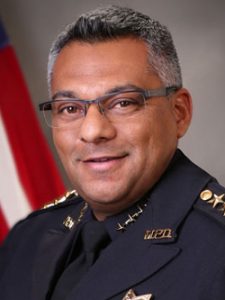Concerned about the recent death of George Floyd at the hands of Minneapolis police and other social inequities, residents posed questions Wednesday to the Martinez City Council about Martinez Police Department and municipal activities.
 The inquiries and comments began during the public comment portion of the meeting, a time period dedicated to items that are not on the agenda. They continued after Police Chief Manjit Sappal gave a detailed report on his department and what it already has in place to prevent police brutality and improper behavior.
The inquiries and comments began during the public comment portion of the meeting, a time period dedicated to items that are not on the agenda. They continued after Police Chief Manjit Sappal gave a detailed report on his department and what it already has in place to prevent police brutality and improper behavior.
And that conversation should continue, members of the Council and Sappal said.
Justin Gomez said this is an “unprecedented moment” and noted that Martinez has had three protests since Floyd’s death and suggested anger and protests eventually become policy.
He said African-Americans are worried about walking down some Martinez streets, and as a brown-skinned man, he has “knots in my stomach” when he sees a patrol car, even though he personally has no history with Martinez Police.
He asked whether Martinez is doing everything possible to keep communities safe, and urged the city to “take a hard look in the mirror” and examine its budget priorities and policing policies “so black lives matter.”
Tali Ray said she lives in what is now Vice Mayor Mark Ross’s district, and said in her 10 years in Martinez, “the police have failed to show me they are trustworthy.” She asked for a public meeting in spring about her and others’ concerns.
Others called for a “reimagining of public safety” in communities of color and for those with mental illness or who are homeless. Some said African-Americans fear shopping in Martinez.
Some recommended adopting “8 Can’t Wait” police reforms that call for a ban on choke holds and strangle holds; require de-escalation practices; require warnings before an officer shoots; require exhausting other approaches before using a firearm; require officers to intervene if another officer is acting improperly; bans shooting at moving vehicles; requires a “use of force continuum” that specifies what techniques are permitted against a resisting subject in a specific situation; and requires comprehensive reporting.
They asked for alternatives to calling police especially in mental health incidents.
Attorney Andrea Crider described how members of her own family were harassed by police for having no identification because they were homeless, and knows of homeless people whose car was towed. She said that makes the unhoused reluctant to contact police when they need help. She added that “Black Lives Matter should mean that.”
Megan Leonard said she was “disheartened” by Mayor Rob Schroder’s statement issued after Floyd’s death. The wife of an African-American, she said members of her family have experienced racism both in city encounters and in schools, and said she has seen confederate flags at the Martinez Farmers Market.
That sight “affected me and the ones I love,” she said.
Charlie Manzano, a lifetime Contra Costa County resident who moved to Martinez five years ago, said he was “ashamed to say I live in Martinez.” He said the homeless are harassed, protesters don’t feel safe and he worried about seeing “Blue Lives Matter” being advocated.
He said resources need to be shifted, such as to the Contra Costa Regional Medical Center, which he said is struggling financially.
Sappal, who was chosen as the city’s police chief five years ago, was prepared with a report to the Council and the public, available online.
He said preventing inappropriate police incidents starts with strict hiring practices and an emphasis on training. Martinez Police Department’s training exceeds the regulations set down in California by the Peace Officers Standards and Training (POST) Commission.
Candidates are given “a rigorous evaluation” that involves a deep-dig background check, a psychological assessment and a fit assessment. He wants employees who “can communicate, have compassion and empathy.”
Lateral hires – those coming from other departments – remain on probation for 12 months. New officers are on probation 18 months.
Since 2015, Sappal has hired 17 officers, with 53 percent retained after completing probation. He also hired 14 dispatchers, of which 28 percent were kept after probation.
Martinez police training exceeds POST guidelines, and that extends to continuing training, in areas of arrest and control, tactical firearms, communications and interpersonal skills. Officers must undergo “essential training in critical areas” – 32 hours of crisis intervention training, and get use of force and de-escalation training each quarter. The department now has two in-house procedural justice instructors, he said.
Additional training, prompted by recent events, is being scheduled, he said. The whole department will be educated in recognizing and handling implicit bias. In addition to the classroom studies on force and de-escalation, officers will receive scenario-based training that would simulate what they might experience in the field.
Even when the department is short-staffed, Sappal said he cuts no corners in his hiring practices. Currently four of the 33 sworn staff positions are vacant, and of the six dispatchers authorized, two positions are vacant.
The department is diverse. Sappal himself is an immigrant and the first police chief in the United States of Indian ancestry. More than a third of the department are from minorities, and they come from “all walks of life,” he said.
The chief said he experienced discrimination, including that from police, when growing up in the Richmond-San Pablo area, and despite his family’s strong objections, entered the field of law enforcement to make a difference.
His own hiring was controversial. The decision came down to a longtime member of the department and a Martinez native son and Sappal, who has worked with Pittsburg and Richmond police. When he was interviewed, he was advised to enter a back way, because the audience had at least 50 people who opposed his hiring. But Wednesday night, Councilmembers told him the city had made the right decision.
City Manager Eric Figueroa is Latino, Sappal said. And in his own command staff, the captain is a woman, and one lieutenant is of Filipino heritage and the other of Italian background. Diversity extends to the sergeant level as well, he said. Two members of his department are African-American.
DataUSA statistics indicate that Martinez itself, which has a population of 37,900 people is 67.7b percent white, 14.9 percent Hispanic or Latino, nearly 8 percent Asian, 4.75 percent of mixed races and 3.34 percent African-American. Of other residents, 96 individuals identify as another race than those listed, 37 people are of Native American or Alaskan races and 21 are Native Hawaiian or other Pacific Islander races.
The department is putting software in place so records, from commendations to complaints to internal investigations, shift from paper to electronic forms. It will have an early intervention component so potential problems can be spotted early and dealt with more quickly.
Although many speakers suggested the police should lose some funding that would go instead to other forms of social service, one policing element that has a hefty cost for the department is body-worn cameras.
Sappal wants them. He called them an “excellent tool for accountability and organizational improvement.” He has the backing of the Council. The only drawback is the cost, both for the cameras and for the even more costly information storage.
At Wednesday’s meeting, Sappal said the Council authorized a one-time allocation in April that would address department priorities that have been put on hold, and acknowledged the department must move faster on acquiring body cams.
Their use is governed by regulations and law, and Sappal said in his department, his officers would be required to turn those cameras on as they exit their patrol cars.
Concerning use of force, Sappal said the number of incidents in which force is used is low. “Use of force” is noted anytime an officer touches a suspect, Sappal said. That can include blanketing a kicking suspect’s legs or placing a hand on a suspect.
In 2019, Martinez police reported 33,202 incidents; of these, force was used in 0.05 percent of the time. This year, through June 9, officers have responded to 15,166 calls, and of these, 0.03 percent involved “use of force” procedures.
Sappal outlined California legislation that governs use of force, training and transparency, and said the city complies with or exceeds most already, and will comply with Assembly Bill 978 once body cameras are acquired.
California has been upgrading its use of force regulations, and at this time, Martinez Police policies are ahead of the game. It already has banned carotid holds and never has used chokeholds. While Martinez already is modifying de-escalation procedures regarding use of force, more policies are expected to be handed down from federal and state levels, and those changes will be incorporated once they’re defined, he said.
As he promised Wednesday, Sappal has posted recommendations concerning the “8 Can’t Wait” initiative, available at https://www.cityofmartinez.org/civicax/filebank/blobdload.aspx?BlobID=19980.
In that document, he said his department doesn’t use chokeholds or strangleholds, and banned use of the carotid restraint; that de-escalation of situations is the underlying theme of the department’s training, policy and operations; and that when it’s objectively reasonable, safe and feasible, officers should evaluate the use of other resources and techniques before employing deadly force.
He said his department doesn’t outright prohibit shooting at moving vehicles, but discourages it unless an officer believes there is no other reasonable means available to avert a threat of death or great bidily injury. He said the “use of force continuum” now is considered outdated in its approach to de-escalation, and his department instead looks to Senate Bill 230 and its urging to create space and separation. Martinez’s policy separates “deadly force” form other use of force, his statement said.
While “8 Can’t Wait” calls for comprehensive reporting when officers point or fire weapons, Sappal said all of his department’s actions are documented, and Senate Bill 1421 requires an incident report subject to public disclosure when an officer discharges a firearm at another person. Senate Bill 230 has its own requirements for internal reporting and notification, he said.
As for requiring officers to intervene to stop excessive force by other officers, Sappal said his policy already mandates that. And for warning an individual before an officer fires, Sappal’s statement said officers, when feasible, will identify themselves and warn that deadly force may be used in cases when a fleeing person is believed would case death or serious injury unless apprehended.
Sappal added a personal note, saying he is “deeply troubled by the criminal senseless and brutal act against George Floyd. There is no aspect of how he was treated that is consistent with the oath a Police Officer takes to protect the public.”
Anytime a Martinez officer uses force, the incident is investigated by a sergeant, then a lieutenant, the captain and the chief himself. If the action is outside department policy, it’s investigated further, including an Internal Affairs examination. Corrective action is taken, which could be training, counsel or disciplinary measures.
But it doesn’t stop there. The incident then is incorporated into additional training department-wide, Sappal said.
The chief doesn’t see his department remaining static. Besides adding body cameras, he is hoping to participate in the development of a regional crisis intervention team, a step beyond the social services work already being done in Martinez.
He agreed with one speaker that more training is needed in recognizing behavior of mentally ill and autistic people, whose actions may be misinterpreted.
But on his first day with the department, he realized its officers had a high degree of sympathy. He arrived on one call to see an officer tending to wounds of an individual – the suspect in the case. He said his employees work hard every day, although, “We can always do better.”
He also acknowledged that in some cases, others besides police could offer a better response, from the regional team being discussed to Martinez’s shared outreach team.
This city, along with partner Pleasant Hill, was the first in Contra Costa County to underwrite a Coordinated Outreach Referral, Engagement (CORE) homeless outreach team.
That move happened after city officials realized that sometimes a uniformed officer doesn’t always make the best impression in some areas of the Martinez community.
While other emergency services can be reached through 9-1-1, the Martinez-Pleasant Hill CORE team is reached by calling 2-1-1.
Officer Rodney Brinser, whose attire is less formal than the usual uniform, is assigned exclusively to homeless residents, and depending on how city finances are affected by the COVID-19 pandemic and shelter-at-home regulations, Martinez Police may designate a second officer to the homeless.
The outreach is having a positive response – more and more people are considering alternatives to life on the streets, Sappal said. He praised additional work by Councilmember Noralea Gipner and Bay Church, which has built and supplies portable showers. Those showers had to be suspended during the pandemic restrictions, but should resume later this year.
Other partnerships are a clothing exchange and laundry service as well as Loaves and Fishes, which offers weekday lunches.
Sappal urged members of the public to reach out themselves to police. They can take ride-alongs with officers. Once the pandemic rules are loosened, Sappal promised a return of the annual Community Police Academy, an in-depth series of training classes that let members of the public get a glimpse of how officers are trained and what daily police life is like.
He wants town hall meeting with the public, although at this time the meeting likely would be handled online through Zoom, just as the Council meetings are. And he wants to form a Police Chief Advisory Panel.
If anyone questions actions by members of his department, “contact me,” Sappal said. Complaints can be filed on a city website portal or emailed to him through the city website, https://www.cityofmartinez.org/depts/police/default.asp.
Expanding on the presentation he gave Wednesday, Sappal said he wants to give the City Council an annual Use of Force report.
He acknowledged calls for restructuring city budgets to remove money from policing to social agencies. But if the department loses a third of its funding, residents will see a serious impact, Sappal said. “When you call 9-1-1, you expect an officer to show up,” he said.
Nor does he have authority outside his department, he said in response to those who asked about policing at the county level and elsewhere.
But he agreed with residents that Martinez Police must be accountable. Laws and processes already are in place to require that.
“We’ve got good people working here,” he said. “Once the legitimacy is questioned, we lose effectiveness. We have the process in place. If you think or hear something differently, let us know.”
In other action Wednesday, the Council accepted as completed the 2019-20 Measure D Pavement Rehabilitation and the 2016 Flocculator Paddle Replacement and Finished Water Pipe Improvement projects; approved sending the report of Measure J Growth Management Program Compliance Checklist Report for Fiscal Yeas 2017-18 and 2018-19 to the Contra Costa Transportation Authority so the city could receive more than $1.2 million in Measure J funds; resolved to be subject to the Public Employee Medical and Hospital Care Act, a cost-saving benefits move; and agreed to consolidating its Nov. 3 city general elections with others in Contra Costa County.
Those who want to view a recording of the meeting may do so at https://martinez.granicus.com/MediaPlayer.php?view_id=7&clip_id=1609.




